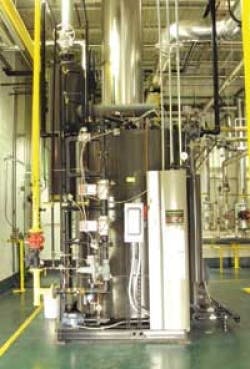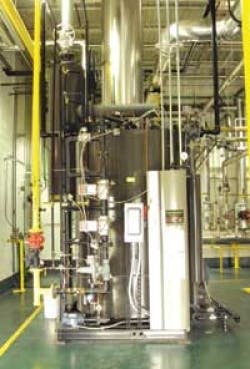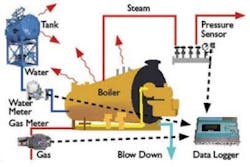Boiler Maker Maximizes Efficiency for Fabric Leader
By Mark Utzinger
• Quick steam, convenient load-pattern matching, in-service efficiency, and computer controls make Miura Boiler the choice of a worldwide leader in performance fabric manufacturing.
Founded over a century ago, Glen Raven is today a global leader in the creation of performance fabrics used for awnings, casual furniture, sails and boat canopies, and many other demanding outdoor applications. Based in Glen Raven, NC, Glen Raven Technical Fabrics LLC recently upgraded its textile dyeing and finishing infrastructure by installing five Miura EX-300 industrial steam boilers. Engineered for quick start-up, fuel economy, and reduced emissions, these boilers provide Glen Raven with the flexibility to meet ever-changing demands of its manufacturing processes.
“We made a lot of system changes when we went from our two previous large boilers to our smaller bank of five Miura Boilers,” states Mike Harrington, project engineer for Glen Raven’s Technical Fabrics Group. “The new system is paying off and Miura Boilers are a big part of that. We have seen improvements and increased efficiencies.”
“We’re running anywhere from 80-87% efficient with the Miura boilers,” says Steve Holt, recently retired head operator and plant engineer at Glen Raven. “We have an erratic steam load, but you can bring these boilers up fast and have them online in about 10 minutes.
Miura boiler at Glen Raven Technical Fabrics facility in Glen Raven, NC
“Demand swings greatly,” adds Harrington, “but we can fire the Miura EX-300 boilers off in sequence, so we don’t have a big boiler sitting there idle.”
Glen Raven’s multiple installation (MI) of these five compact steam boilers can be turned on or off in varying numbers to match prevailing load patterns, thus saving fuel and water, as well as minimizing the emissions typically produced by idling boilers. In addition, the NOx (nitrogen oxide) rating of Miura’s EX Series boilers can be as low 30 ppm, depending on the boiler model.
Miura Boiler also offers an MI controller that turns boilers on or off to match load patterns and achieve the highest possible in-service efficiencies, which are a measure of overall boiler performance (regardless of load profile) that takes into account all factors of boiler operation (combustion efficiency, thermal efficiency, fuel-to-steam efficiency, etc.) and total operation cycles.
The “once-through” design of the boilers turns water to steam in just five minutes and, on average, saves 20% in fuel costs over other boiler designs (based on today’s fuel costs). At a 20% fuel savings, this amounts to savings of about $200,000 a year in fuel for a typical 600 BHP steam system (with natural gas at $0.09/therm).
Harrington explains that Glen Raven’s five Miura boilers supply steam to the company’s process dye houses. “We’re heating water, and getting to temperatures of 265°F in pressure vessels to do textile dyeing,” he explains.
“We send steam about a quarter of a mile down the road to the other plant,” says Holt, “and we don’t have any problems with wet steam. Miura boilers are also safer and a lot easier to operate than the old boilers, with not near as much maintenance.
“With their computer controls, on-board diagnostics, and the safeties that are in there, Miura boilers just don’t require the high level of manual observation that old, larger boilers did,” agrees Harrington.
In-service efficiency study schematic for boiler
Miura’s BL Micro Controller Boiler Control System keeps track of multiple individual monitoring points. Should a problem arise, the system identifies it and suggests a solution in plain, descriptive English on an easy-to-read display. An online maintenance system with a “sliding window feature” records events four seconds before they occur for quick identification and correction.
Glen Raven’s Miura boilers were purchased from Boiler Masters, in Greensboro, NC. “Boiler Masters did a great job working with our team and helping with the transition from our old boilers,” notes Harrington. “They also do maintenance for us, so it’s a good relationship that has been built out of this project.”
About the Author: Mark Utzinger is vice president at Miura Boiler, which was founded in 1927 and is one of the largest industrial steam boiler manufacturers in the world. With world headquarters in Japan and U.S. operations based out of Englewood, NJ, Miura opened a new U.S. manufacturing facility in Polk County, GA, in 2009. Contact: 888-309-5574 (USA), 800-666-2182 (Canada) or www.miuraboiler.com


